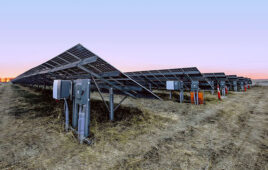 Turning on a light indoors while the sun is shining outdoors creates frustration for an environmentalist. Knowing that a simple flick of the light switch causes a chain of energy production, transportation and conversion just seems crazy when the sun is pouring down free photons outside only a few feet away.
Turning on a light indoors while the sun is shining outdoors creates frustration for an environmentalist. Knowing that a simple flick of the light switch causes a chain of energy production, transportation and conversion just seems crazy when the sun is pouring down free photons outside only a few feet away.
One often proposed solution for this is to use a heliostat, which is a mirror mounted on motors that tracks the sun throughout the day and places the reflection of the sun on a fixed spot, like the window of a house, but heliostats traditionally have been expensive, costing thousands of dollars each, and only suitable for government research. A team of engineers and manufacturing experts at Wikoda Inc. in Concord, Massachusetts have developed a heliostat designed and priced for residential use, enabling homeowners to add brightness and warmth to dark or gloomy rooms. A single heliostat reflects up to 50,000 lumens of sunlight and can completely transform the mood of a room (one 60 watt bulb provides 1000 lumens).
Based on a typical $0.15 per KWhr cost of electricity, the Sunflower Home Heliostat provides the equivalent of $2 per day of free natural lighting each sunny day. On a yearly basis, the Sunflower Heliostat provides $200 to $600 of free lighting per year depending on local sky conditions, making it a form of alternate energy with an unusual rapid payback.
Not surprisingly, sales of heliostats have been brisk and interest has come from worldwide. In fact, demand from countries like Australia, the UK, France, Germany, Italy, Belgium, New Zealand and the Netherlands was so high that Wikoda Inc. pushed for, and received the European CE certification on an accelerated schedule to allow shipping into those regions with full government approval. These new markets are in addition to the domestic United States market for which the heliostat had already previously received FCC government approval.
Unlike heliostats intended for industrial purposes, a home heliostat from Wikoda Inc. does not require any programming or scientific knowledge to set up. The computer, motion servos and sun sensors are all on-board and self contained. It doesn’t even need batteries or a power cord because the heliostat itself is solar powered. All that is required are typical homeowner tools, like a screwdriver and wrench, and a sunny patch of yard. Once set up and operating, the heliostat tracks the sun every day and pumps sunlight in through a window providing free light and warmth.
People have used heliostats to brighten rooms, grow indoor plants, provide warmth, melt icy roofs, dry clothes, dry woodpiles, discourage moss or mildew and jumpstart spring flowers. Once up and running the heliostat steers a beam of natural sunlight to a location of the owner’s choosing day after day while saving money, carbon, and the environment.
Wikoda Inc.
www.homeheliostat.com





Is it possible to put a heliostat on the roof and direct sunshine into a dark patio below?
There’s a free heliostat beeing developped by a user in Spain. It’s here https://www.youtube.com/watch?v=28KvLwcSss8
How to install in homes which are close to each?
Intact the sunlight not entering some rooms is due to the proximity of buildings.
you could use lenses and mirrors or tubes lined with reflective material like space blankets/
They only sell them online
Where can I source this in the UK please?
posted this most-excellent article to enenews.com, it the renewable/alternative energy forum.